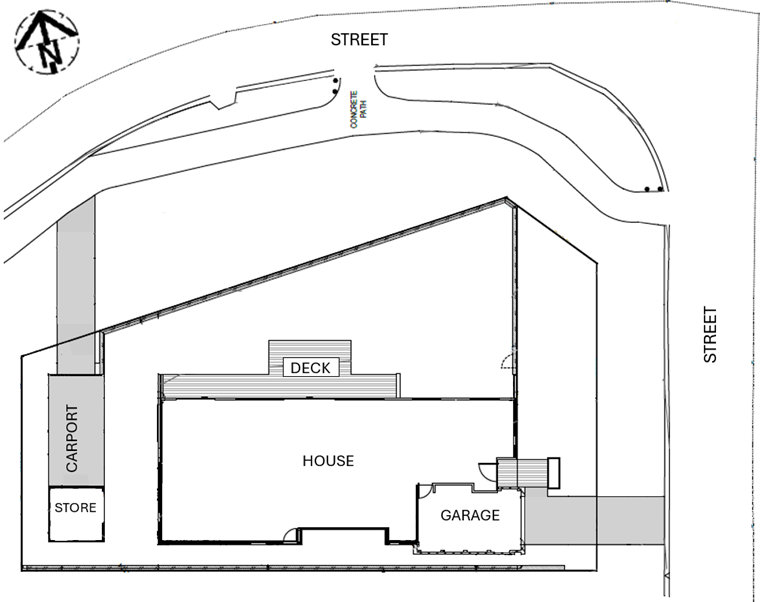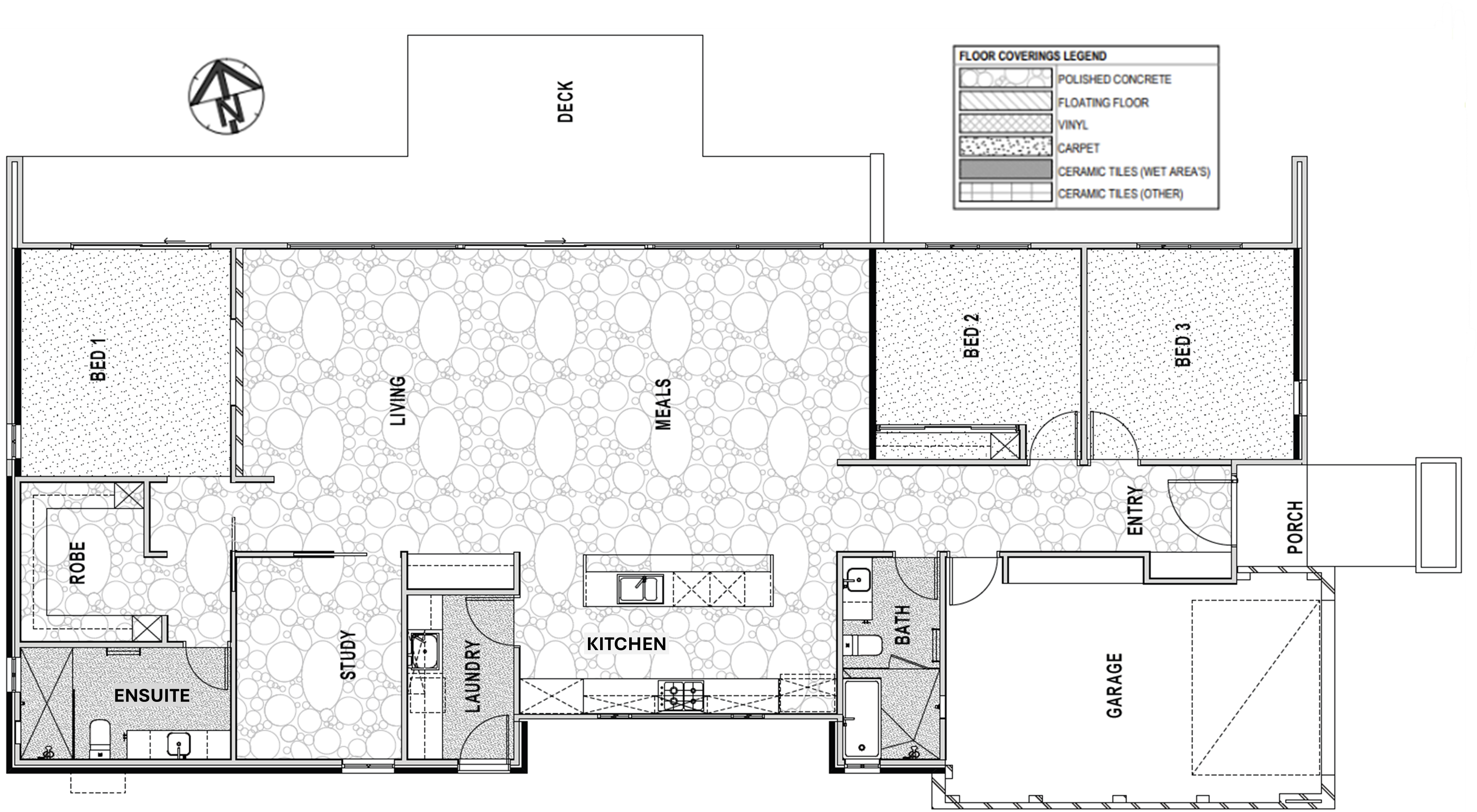Collie, Western Australia
This modern and cost-effective new build, based on the Design For Place Banksia House, has created a practical family home.
This new home takes advantage of orientation and passive design principles to provide a comfortable home year-round.
Photo: White Building Co.
NatHERS thermal comfort rating
8.0 Stars
Heating: 29.2 MJ/m² annually
Cooling: 16.2 MJ/m² annually
Total: 45.3 MJ/m² annually
Sustainability features
- Passive solar design
- Double glazing and low-e single glazing
- High thermal mass with concrete floors and select reverse brick veneer internal walls
- LED lighting throughout
Project details
Building type: Low-density housing
NCC Climate zone: 5 – warm temperate
Designer: Arcadia Building Design
Builder: White Building Co.
Size: 187.1m² (including 26.3m² of garage)
Cost: $350,000
Site, block orientation, location and climate
The house is in the town of Collie in south-western WA, 60km inland from Bunbury and 180km south of Perth. The local climate is warm temperate. Winters are cool to cold with average July temperatures ranging from 4°C to 15°C. Summers are mild to hot, with January temperatures ranging from 13°C to 30.5°C.
The house faces north-north-east (NNE) on a 675m² corner block with a long northern boundary.
Site plan.
Plans: White Building Co.
Design brief
The owners wished to downsize to a practical, space-efficient family home featuring 3 bedrooms, 2 bathrooms and a study. Energy efficiency, solar passive design and cost-effective design and construction were essential considerations. A Bushfire Attack Level (BAL) rating of 29 created additional challenges and constrained material selection.
Floor plan.
Plans: White Building Co.
Design response
After selecting the Design For Place Banksia plan, the owners worked with their draftsperson to modify the design to suit their needs and preferences. This included flipping the original design from east to west, adding a Velux skylight in the main entry and adding a detached carport and storage area.
Energy-efficient LED lighting has been installed throughout the home, complementing the abundant natural light from the north-facing windows and the entry skylight. Efficient taps, toilets and showerheads, all with a minimum 4-star WELS rating, were also selected.
A variety of wall construction methods were used including stud clad, brick veneer and reverse brick veneer. The reinforced concrete raft slab is 100mm thick and insulated with a poly membrane underneath.
The roof is Colorbond steel sheeting, which is highly recyclable at the end of its life. The southern face and around the garage door on the eastern end feature brick veneer while the remainder of the external cladding is fibre-cement.
The longest side of the house, which strategically contains the living areas and bedrooms, faces NNE to take advantage of the natural light and solar gain during the colder months.
Photo: White Building Co.
Windows and doors
Argon-filled low-e double glazing was used for the larger living area north-facing windows while low-e single glazing was chosen for other windows and doors. All frames are conventional aluminium. The Design For Place plan places most glazing on the northern side, with many of these windows operable to allow for cross-ventilation with the house’s south-facing windows. Glazing on the eastern and western ends is minimised to reduce heat gain from low-angle sun in summer.
Heating and cooling
Design For Place emphasises energy-efficient building design including smart window placement and thermal mass to maximise solar heat gain in the colder months, which maintains a consistent, comfortable temperature year-round.
The home’s living areas and bedrooms face NNE, allowing sunlight to fill these rooms in winter. This in turn will warm the polished concrete floor and the exposed brick wall in the living room. The covered brick walls in the bedrooms help moderate indoor temperatures, ensuring year-round comfort.
The 1500mm eave on the north side of the house shades the windows and concrete floor during the summer while allowing winter sun to warm the house. A sun study was completed to ensure the eave design would meet these seasonal needs.
The combination of effective low-e and double glazing and well-insulated roof and walls helps to maintain a comfortable indoor temperature year-round.
Windows and doors on the north and south side of the living and kitchen areas can be opened to allow cooling breezes to flow freely through. Ceiling fans are installed in the living/dining area and in each bedroom. Additionally, a single reverse-cycle split system air conditioner (9.4kW cooling, 10.3kW heating) is installed in the living area for extra cooling or heating when needed.
The polished concrete slab and exposed reverse brick veneer wall provide thermal mass, helping to regulate indoor temperatures.
Photo: White Building Co.
Insulation and draught sealing
Most of the ceiling received R4.0 fibreglass batts, while R6.0 batts were used in the raked ceilings in the living areas as the limited roof space required insulation with a higher R-value.
Anticon reflective insulation was installed beneath the metal roof.
Excluding the garage, all internal walls were insulated with R2.5 fibreglass batts and external walls are fitted with insulated reflective sarking.
All external doors and windows are weather sealed and exhaust fans in the kitchen and bathroom are self-sealing to reduce heat loss.
Evaluation
This adapted Design For Place Banksia House is aesthetically simple, modern and sleek. It has realised the objectives of practicality and cost-effectiveness while fully integrating passive design principles. The family enjoys the sense of comfort, light and space it provides, making it truly feel like home.
The house has earned the following awards:
-
WINNER 2021 HIA South West Custom Build Home up to $370,000
-
WINNER 2021 HIA South West GreenSmart Sustainable Home
-
WINNER 2021 HIA South West Innovation in Lightweight Housing up to $350,000
-
FINALIST 2021 HIA South West Custom Build Home of the Year
-
FINALIST 2021 HIA South West Innovation in Housing
Author
Department of Climate Change, Energy, the Environment and Water, 2025
Learn More
-
Next case study - Perth, Western Australia
-
Explore another Your Home case study of an adapted Design For Place Banksia House in Inverloch, Victoria
-
Learn how to use the Design For Place free house plans
-
Understand more about Passive design







